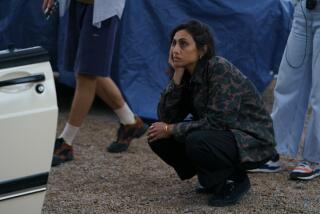The mother of modern theater
- Share via
Eleonora DUSE transformed the nature of acting. Though she died nearly 80 years ago, her influence lives in the work of movie stars today, men and women schooled by the generation of American acting teachers who had seen Duse perform when they were young and half a century later still held her up to their students as the exemplar of what an actor could be. Lee Strasberg and Stella Adler, who agreed about virtually nothing else, both worshiped her. “The Theatre will require the next hundred years to deal with what Duse represented,” Strasberg told his students at the Actors Studio. “There is none like her -- none,” English actress Ellen Terry marveled in 1893. Russian director Konstantin Stanislavsky was inspired by Duse’s artistry to create his famous “system,” which continues to dominate actor training.
What was so extraordinary about her? How did an actress who performed only in Italian, in plays that (with the major exception of Henrik Ibsen’s works) are forgotten today, make such an enduring impression across the globe and across the decades? Writing with passion and sensitive attention to detail, Helen Sheehy, author of several previous theater biographies, combines evocative quotes from people who saw Duse onstage with her own well-informed commentary to make palpable the electrifying emotional charge of Duse’s acting and to elucidate its historic effect. “She was the first modern actor,” Sheehy avers. “She ransacked her scripts, digging beneath the lines of her characters not to reveal certainty, but to portray what she called the invisible side of life. Duse’s humanistic art and her revolutionary approach to language anticipated the complexity, fluidity, and impermanence of the modern world.”
The world was very different in 1873, when the 14-year-old Duse gave her breakthrough performance as Juliet. Acting in those days was “bombastic and exterior ... primarily a pictorial art,” writes Sheehy, displaying an ability to place her subject in context that distinguishes the entire book. After seeing international star Adelaide Ristori play Lady Macbeth, the impudent Eleonora remarked, “I felt an overwhelming urge to straighten my room.”
Duse, who had been onstage since age 4, came from a more naturalistic tradition. Her grandfather, whose red velvet waistcoat she kept all her life, was a star of the commedia dell’arte, famed for the spontaneity of his acting. The family’s fortunes had fallen considerably by the time she became leading lady of their struggling, itinerant troupe, but at 14, Duse already was sure there was more to a performance than posing. As Juliet, she later recalled for her lover Gabriele d’Annunzio, “The words flowed with strange ease ... I could hear them through the constant drumming of my heartbeat.... There was not a fibre in me that did not contribute to the harmony. Oh, grace, it was a state of grace!”
Duse rarely found that state of grace in daily life, where she frequently indulged in the hysterical self-dramatization she never permitted herself while acting. Her marriage (to a mediocre actor) lasted barely three years, and she freely confessed a visceral physical repugnance for the daughter who reminded her of that unhappy union. Her friendships were intense but strictly on her terms; women who were initially embraced as “guardian angels” or “daughter” found themselves unceremoniously dropped when they ceased to be useful.
Her two most important love affairs were with men she hoped would write plays to fulfill her vision of a new theater, Verdi librettist Arrigo Boito and literary bad boy D’Annunzio. Only her voracious reading seemed to make her as happy as performing; it’s no accident that she was one of the first to insist that an actor must serve the text, not vice versa. She was enormously appealing and charismatic, but she was not very nice. Sheehy is frank about Duse’s faults but doesn’t waste our time bemoaning them. The author understands that an artist’s personal life is interesting primarily for its effect on her art, especially in the case of someone like Duse, who lived to work.
It’s the work, and particularly its galvanizing effect on those who saw it, that’s so well-captured here. In Sheehy’s persuasive assessment, Duse was a revolutionary from the beginning. Denied schooling and rejected by polite society because she was a traveling player, the self-educated teenager displayed an unshakeable self-confidence even when demoted to seconda donna (supporting actress) in other people’s companies after the family troupe failed in 1873. “What makes you think you’re an artist?” shouted one actor-manager, infuriated by her refusal to take line readings and her radical use of silences to convey meaning. Duse wouldn’t budge: “She sought to evoke the quivering wordless emotion of the body and to express the quickening agitation of thought with no separation between the two.” Critics in Naples were describing that approach as “completely modern” as early as 1879; before Duse could complete her conquest of Italy by triumphing in Milan in 1884, she had to overcome the qualms of theatergoers startled by her pallor (she never wore makeup) and her failure to strike the expected poses.
In a pattern that would endure to the end of her life, Milan audiences were initially cool to Duse’s innovations but won over in the end by the emotional and psychological depth of her performances. She made her paradigm-shifting intentions explicit when she appropriated the signature role of her great rival, Sarah Bernhardt: Marguerite in “La Dame aux camelias.” Fourteen years older than Duse and the epitome of the French academic style, Bernhardt played Marguerite as a tragic heroine; Duse played her as a suffering woman. Sheehy’s comparison of the two actresses is cogently stated, but this is a case where photographs -- well chosen and used by the author throughout -- say it all: At the top of a page, Bernhardt reclines gracefully on a divan, her lovely face turned toward the camera to display the theatrical grief caused by the letter carefully displayed at arm’s length in her lap. Below this pretty picture, Duse sits hunched over the same letter, her knees clumsily apart, her face in shadow, eyebrows furrowed, her entire body expressing bewilderment and pain. It’s not a dramatic image; she doesn’t look beautiful, but she does look real. From this apotheosis in Milan to her death while on tour in America 40 years later, Duse’s audiences felt that they were not so much watching her act as sharing a living experience.
Yet she was no blindly instinctual actor coasting on her feelings. As the narrative progresses through Duse’s many world tours and her increasing fame prompts eyewitness accounts by various shrewd observers, we see fellow artists thunderstruck by her flawless technique. Charlie Chaplin was one of the many to celebrate her ability to reveal a world of emotion in a single gesture. Viennese poet Hugo von Hofmannsthal commented that she enriched the playwright’s text by “untangling [the] chain of thought, the interior psychological-physical event that precedes the formation of a word.” This made her the first great interpreter of Ibsen, whose plays required actors who could portray “a real and living human being” and also understand the social and spiritual challenges his work posed. The general public never liked “A Doll’s House” or “Hedda Gabler” as much as the old-fashioned melodramas in which the young Duse made her reputation, but she didn’t care. “To stand still is fatal,” she explained when asked why she insisted on performing only D’Annunzio’s plays on her 1902 American tour. His murky symbolist allegories were hardly at Ibsen’s level, but Duse’s commitment to growth and change kept her art fresh.
Chronicling this remarkable career, Sheehy occasionally lapses into the overheated ardor that Duse in her long heyday elicited even from hardened journalists. (“Genius Enthralls Throng With Her Super-Art,” a Los Angeles newspaper headline announced in 1924.) But an enthusiastic biographer is greatly preferable to a carping one, and such judicious comments as “onstage Duse could forget herself ... offstage she thought about herself constantly” far outnumber flights of cloudy rhetoric like “she realized the inevitability of her own death, the precious precariousness of life, and she developed a consciousness of humanity’s fate.”
“The actor vanishes without a trace,” Duse once said, but Sheehy’s intelligent, appreciative portrait recaptures performances no one now living has seen and illuminates their significance in theater history to make it clear that Duse was one of those rare actors who left an indelible trace on the art form to which she dedicated her life.
More to Read
The biggest entertainment stories
Get our big stories about Hollywood, film, television, music, arts, culture and more right in your inbox as soon as they publish.
You may occasionally receive promotional content from the Los Angeles Times.










